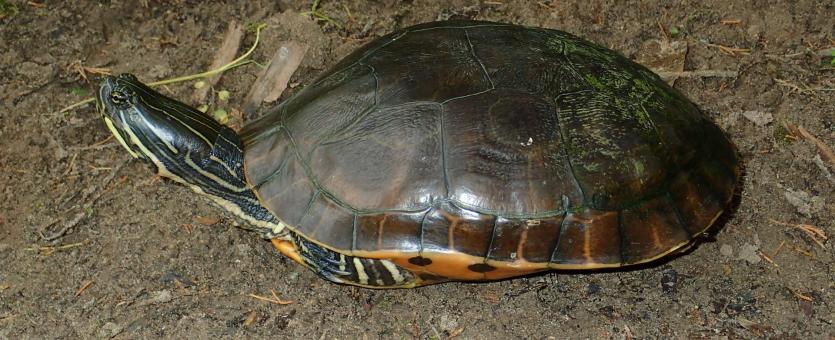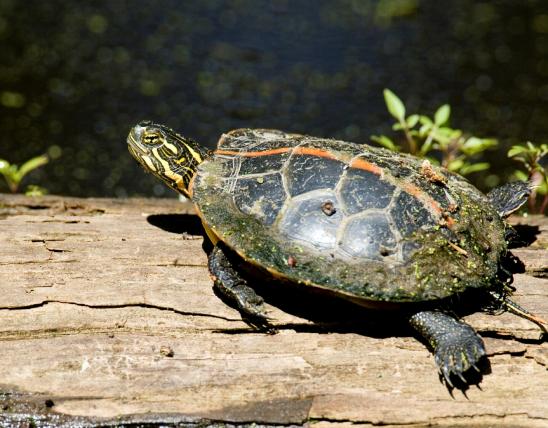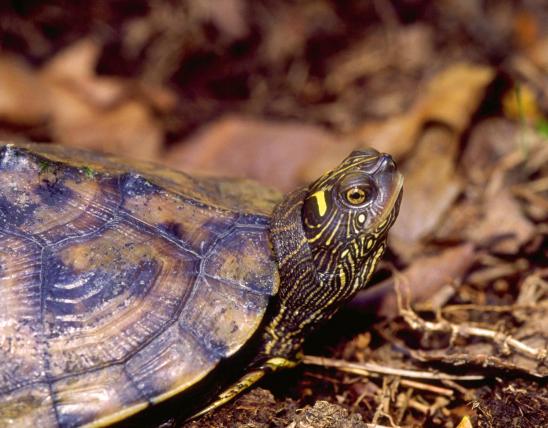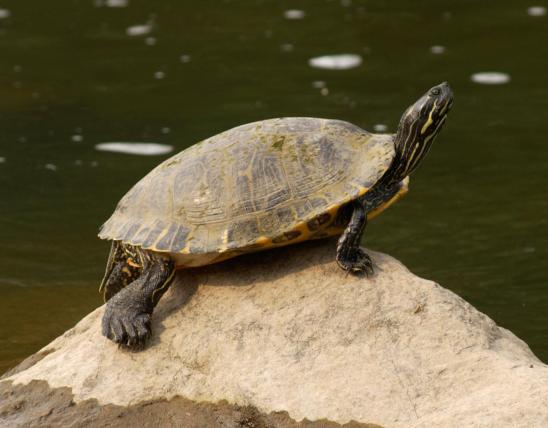
The western chicken turtle is a small to medium-sized turtle with an oval shell and extremely long neck. It is one of the rarest species of turtle in Missouri, occurring only in the Mississippi Lowlands in the extreme southeastern part of the state.
The western chicken turtle has a rather flattened appearance caused by the low, broad shape of the shell. The carapace (upper shell) may be light brown or olive, with faint, broad lines forming a netlike pattern. The plastron (lower shell) is yellow with brownish markings along scute (shell-scale) seams. The exposed skin is brown or black with numerous yellow or yellow-green stripes. The forelimbs have a wide yellow stripe; the rump has distinct vertical yellow stripes. The underside of the head and neck of adults is plain yellow.
Similar species: Missouri has 11 species (and one additional subspecies) in the pond and box turtle family. Ones that also occur in Missouri's Bootheel region include the southern painted turtle, Ouachita map turtle, northern false map turtle and Mississippi map turtle (subspecies), eastern river cooter, and red-eared slider.
Adult upper shell length: 4 to 6 inches; occasionally to 10 inches.

In Missouri, occurs only in the Mississippi Alluvial Basin in the extreme southeastern part of the state. Within North America, it ranges from southeastern Missouri south to western Mississippi, most of Louisiana, and west to southeastern Oklahoma and eastern Texas.
Habitat and Conservation
Although the broader active season is from mid-March into August, western chicken turtles are apparently only active for a brief period in the spring and early summer (into July) and remain buried underground for the remainder of the year.
Chicken turtles are semiaquatic and spend nearly as much time wandering about on land as in the water. A study in Virginia showed that adult turtles take extensive overland excursions that allow them to locate other wetlands.
Chicken turtles prefer shallow, still, or slow-moving aquatic habitats, including swamps, river sloughs, oxbow lakes, and ephemeral wetlands.
This species will bask in the sun on partially submerged logs, often with other kinds of turtles.
Considerable movement on land occurs during the nesting season.
They escape hot, dry conditions by estivating beneath vegetation or leaf litter, or moving among wetlands.
Unlike many other aquatic turtles, chicken turtles overwinter on land in open forests. Many individuals overwinter 164–820 feet from a wetland.
Throughout the species range, population size is generally small, with viable populations containing fewer than 40 adults.
Food
The western chicken turtle spends much time foraging in shallow water. Its long neck allows it to strike quickly to capture prey. It feeds upon a wide variety of invertebrates (such as dragonfly and damselfly larvae, crayfish, and fishing spiders), tadpoles, and occasionally aquatic plants. Missouri's western chicken turtles are presumed to eat mostly crayfish and plants.
Status
The western chicken turtle is state endangered and extremely rare in Missouri. A Missouri species of conservation concern.
It was first reported in our state in 1957, and very few were seen in Missouri until 1995, when a small population was discovered in Butler County. The population in Butler County has declined dramatically, but a new population has been discovered in Ripley County. The chicken turtle requires wetlands and lowland forests to survive. This habitat has been greatly reduced in southeastern Missouri by the clearing of forests and draining of natural wetlands.
At one time the western chicken turtle was probably common in the swamps of extreme southeastern Missouri. Now only a couple of locations are known. Destruction of swampy habitat in the Bootheel is the main cause for their decline.
Life Cycle
In Missouri, this turtle probably is active from mid-March into August.
In Missouri, courtship and mating probably occur in water in spring and early summer, perhaps peaking in June. Females generally deposit more than one clutch (normally two clutches) of 5–12 eggs each year. The eggs are laid in loose soil about 4 inches below ground. Incubation period is unknown for Missouri populations, but is believed to be from 10 or 11 to 21 weeks. Hatching probably takes place in the fall; some hatchlings might remain in the nest through the winter.
Compared to most other turtles, chicken turtles apparently are not long-lived. Few of them survive past 15 years of age.
The reproduction of Missouri chicken turtles has not been studied well. Most research has focused on the subspecies that occur in the southeastern United States.
Human Connections
The name “chicken turtle” apparently comes from the flavor of the flesh, which was said to taste like chicken. Of course, due to this animal’s endangered status, hunting or killing them is illegal in Missouri.
This turtle's habitat has been greatly reduced in southeastern Missouri by the settlement activities of humans: clearing the forests and draining the natural wetlands. Protection of the remaining wetlands and lowland forest, as well as the construction of wetlands and planting of trees, will ensure this animal remains a part of Missouri’s biodiversity.
The genus name, Deirochelys, means "neck-turtle," and it refers to the extraordinarily long neck of this species. The chicken turtle is the only species in this genus. The species name, reticularia, means "netlike" or "reticulated," and it refers to the faint netlike color pattern on the upper shell. The subspecies name for the western chicken turtle, miaria, means "stained," and it refers to the look of the brownish markings along the seams on the bottom shell.
Ecosystem Connections
Western chicken turtles help control populations of the relatively small animals they eat. But many predators eat turtles, especially the eggs and hatchlings, which are relatively defenseless. Even insects can attack a turtle nest and eat the eggs before they hatch.
The western chicken turtle's broader range extends from southeastern Missouri south to western Mississippi, most of Louisiana, and west to southeastern Oklahoma and eastern Texas. Thus our populations are at the northeastern boundary of their current overall range.
Populations that exist on the edge of an overall range often are found to be distinct genetically from the rest, sometimes to the point where they are eventually considered separate subspecies or species. Also, populations on the edge of the range may have a special resistance to disease, or other helpful genetic traits. And given a changing climate, they may be in a geographic position to thrive while populations elsewhere may decline. Another point is that all species occurring within our borders are part of our state's rich wildlife heritage, and it's up to us to care for them.
There are two other subspecies of chicken turtle: the eastern chicken turtle (D. r. reticularia) and Florida chicken turtle (D. r. chrysea). Neither occurs in Missouri. Biologists believe that, of the three subspecies, the eastern chicken turtle is the one most like their common ancestor, and the western subspecies is the one most different. Geographic separation, especially during periods of glaciation, apparently led to their genetic divergence. The western subspecies, especially, has long been cut off from eastern populations by the Mississippi River.
The western chicken turtle is a member of family Emydidae (the pond and box turtle family). This is one of the largest families of living turtles in the world. It comprises 12 genera, containing 52 species. In general, turtles in this family are small to medium sized and are adapted to a variety of habitats. This family includes several colorful species. Although the majority of species are aquatic (such as the eastern river cooter), several kinds are either semiaquatic or have taken to life on land (for example, the box turtles). In Missouri, this family is represented by 7 genera with a total of 11 species and 1 additional subspecies.



























